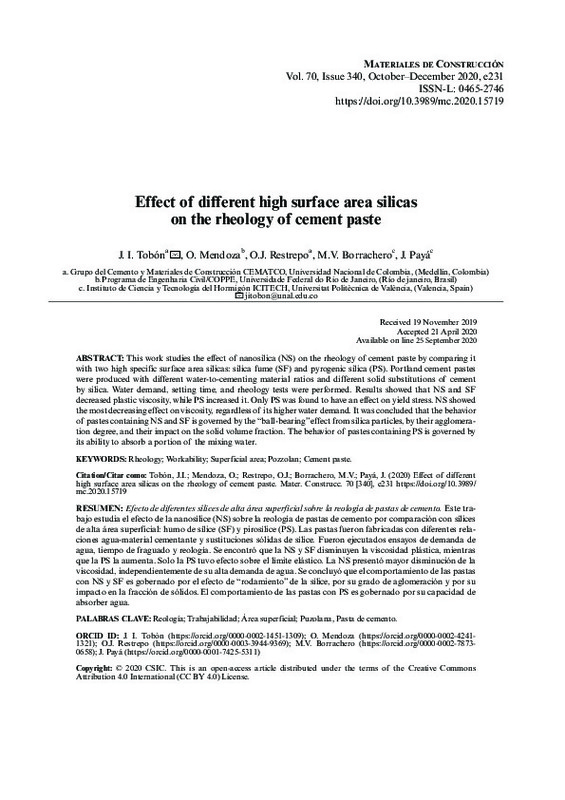1. Kwan, A.K.H.; Li, Y. (2013) Effects of fly ash microsphere on rheology, adhesiveness and strength of mortar. Constr. Build. Mater. 42, 137-145.
2. Jal, P.K.; Sudarshan, M.; Saha, A.; Patel, S.; Mishra, B.K. (2004) Synthesis and characterization of nanosilica prepared by precipitation method. Coll. Surf. A Physicochem. Eng. Asp. 240 [1-3], 173-178.
3. El Sokkary, T. M.; Assal, H. H.; Kandeel, A. M. (2004) Effect of silica fume or granulated slag on sulphate attack of ordinary portland and alumina cement blend. Ceram. Int. 30 [2], 133-138.
[+]
1. Kwan, A.K.H.; Li, Y. (2013) Effects of fly ash microsphere on rheology, adhesiveness and strength of mortar. Constr. Build. Mater. 42, 137-145.
2. Jal, P.K.; Sudarshan, M.; Saha, A.; Patel, S.; Mishra, B.K. (2004) Synthesis and characterization of nanosilica prepared by precipitation method. Coll. Surf. A Physicochem. Eng. Asp. 240 [1-3], 173-178.
3. El Sokkary, T. M.; Assal, H. H.; Kandeel, A. M. (2004) Effect of silica fume or granulated slag on sulphate attack of ordinary portland and alumina cement blend. Ceram. Int. 30 [2], 133-138.
4. Gutsch, A.; Krämer, M.; Michael, G.; Mühlenweg, H.; Pridöhl, M.; Zimmermann, G. (2002) Gas-Phase production of nanoparticles. KONA Powder Part. J. 20, 24-37.
5. Singh, L.P.; Karade, S.R.; Bhattacharyya, S.K.; Yousuf, M.M.; Ahalawat, S. (2013) Beneficial role of nanosilica in cement based materials - A review. Constr. Build. Mater. 47, 1069-1077.
6. Björnström, J.; Martinelli, A.; Börjesson, L.; Panas, I.; (2004) Accelerating effects of colloidal nano-silica for beneficial calcium-silicate-hydrate formation in cement. Chem. Phys. Lett. 392 [1-3], 242-248.
7. Mendoza Reales, O.A.; Silva, E.C.C.M.; Paiva, M.D.M.; M.; Duda, P.; Toledo Filho, R.D. (2017) The role of surface area and compacity of nanoparticles on the rheology of cement paste 25.3. ACI Symp. Pub. 320, 25.1-25.14. https://www.concrete.org/publications/internationalconcreteabstractsportal/m/details/id/51701063.
8. Tobón, J. I.; Mendoza Reales, O.; Retrepo, O.J.; Borrachero, M.V. (2018) Effect of pyrogenic silica and nanosilica on Portland cement matrices. J. Mater. Civ. Eng. 30 [10], 1-10.
9. Mehdipour, I.; Khayat, K.H. (2018) Understanding the role of particle packing characteristics in rheo-physical properties of cementitious suspensions: A literature review. Constr. Build. Mater. 161, 340-353.
10. Boukendakdji, O.; Kadri, E.H.; Kenai, S. (2012) Effects of granulated blast furnace slag and superplasticizer type on the fresh properties and compressive strength of selfcompacting concrete. Cem. Concr. Compos. 34 [4], 583-590.
11. Park, C.K.; Noh, M.H.; Park, T.H. (2005) Rheological properties of cementitious materials containing mineral admixtures. Cem. Concr. Res. 35 [5], 842-849.
12. Deng, H.; Li, H. (2018) Assessment of self-sensing capability of carbon black engineered cementitious composites. Constr. Build. Mater. 173, 1-9.
13. Mendoza-Reales, O.A.; Arias Jaramillo, Y.P.; Ochoa Botero, J.C.; Delgado, C.A.; Quintero, J.H.; Toledo Filho, R.D. (2018) Influence of MWCNT/surfactant dispersions on the rheology of Portland cement pastes. Cem. Concr. Res. 107, 101-109.
14. Quercia, G.; Hüsken, G.; Brouwers, H.J.H. (2012) Water demand of amorphous nano silica and its impact on the workability of cement paste. Cem. Concr. Res. 42 [2], 344-357.
15. Norhasri, M.S.M.; Hamidah, M.S.; Fadzil, A.M. (2017) Applications of using nano material in concrete: A review. Constr. Build. Mater. 133, 91-97.
16. Bowen, P. (2002). Particle size distribution measurement from millimeters to nanometers and from rods to platelets. J. Dispers. Sci. Technol. 23 [5], 631-662.
17. Staiger, M.; Bowen, P.; Ketterer, J.; Bohonek, J. (2002) Particle size distribution measurement and assessment of agglomeration of commercial nanosized ceramic particles. J. Dispers. Sci. Technol. 23 [5], 619-630.
18. Hidalgo, A.; Petit, S.; Domingo, C.; Alonso, C.; Andrade, C. (2007) Microstructural characterization of leaching effects in cement pastes due to neutralisation of their alkaline nature. Part I: Portland cement pastes. Cem. Concr. Res. 37 [1], 63-70.
19. Srinivasan, S.; Barbhuiya, S.A.; Charan, D.; Pandey, S.P. (2010) Characterising cement-superplasticiser interaction using zeta potential measurements. Constr. Build. Mater. 24 [12], 2517-2521.
20. de Larrard, F. (1999) Concrete mixture proportioning a scientific approach, E. & F.N. Spon, London.
21. Banfill, P.F.G. (2006) Rheology of fresh cement and concrete. Rheol. Reviews 2006. 61-130.
22. Burneau, A.; Barres, O.; Gallas, J.P.; Lavalley, J.C. (1990) Comparative Study of the Surface Hydroxyl Groups of Fumed and Precipitated Silicas. 2. Chatracterization by infrared spectroscopy of the interacctions with water. Langmuir. 6 [8], 1364-1372.
23. Xie, X-L.; Liu, Q-X.; Li, R.K-Y.; Zhou, X-P.; Zhang, Q-X.; Yu, Z-Z.; Mai, Y-W. (2004) Rheological and mechanical properties of PVC/CaCO3 nanocomposites prepared by in situ polymerization. Polymer. 45 [19], 6665-6673.
24. Asavapisit, S.; Fowler, G.; Cheeseman, C.R. (1997) Solution chemistry during cement hydration in the presence of metal hydroxide wastes. Cem. Concr. Res. 27 [8], 1249-1260.
[-]









